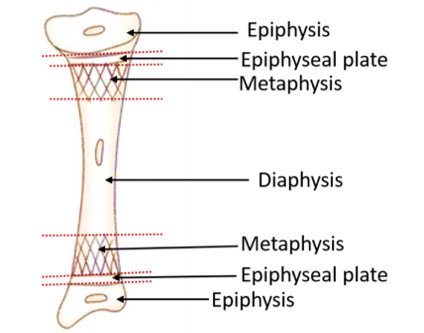What are the parts of Developing Long Bone?
Following are the parts of a developing long bone are:
Epiphysis:
- The ends of long bones that ossify from the secondary centre of ossification are called epiphysis.
- Epiphyses are made of spongy bone covered by a thin layer of compact bone.
- Epiphyses contain red bone marrow, which produces blood cells (haemopoiesis).
Diaphysis
- The elongated, cylindrical shaft of long bone that ossifies from the primary centre of ossification.
- It is made up of compact bone and encloses a tubular cavity called marrow cavity.
Metaphysis
- It is the part of diaphysis that is adjacent to the epiphyseal plate.
- This is the most active site of bone formation in the developing bone.
- It has rich blood supply.
Epiphyseal plate
- It is a thin plate of hyaline cartilage placed between the diaphysis and epiphysis.
- The continuous proliferation of cartilage cells in the epiphyseal plate is responsible for the growth of developing bone in length.
- Epiphyseal plate disappears when the growth in the length of bone stops.

What are the different types of Epiphyses?
1. Pressure epiphysis
o Is present at the ends of the long bone.
o Is articular in nature (involved in formation of joints).
o Takes part in transmission of weight.
o Examples: head of humerus and femur, lower end of radius.
2. Traction epiphysis
o Is produced due to the pull of the muscle and therefore provide attachment to the muscle/s.
o Is non-articular.
o Is not involved in transmission of weight
o Examples: greater and lesser tubercles of humerus, greater and lesser trochanters of femur and mastoid process of temporal bone.
3. Atavistic epiphysis
• Is phylogenetically an independent bone in lower animals but in humans is part of another bone.
• Examples: coracoid process of scapula, posterior tubercle of talus.
4. Aberrant epiphysis
• Is not always present but may be present in some individuals.
• Examples: epiphysis at the head of first metacarpal and base of other metacarpals.
* Normally metacarpals have only one epiphysis i.e. base of 1st metacarpal and heads of other metacarpals.
Pressure epiphyses ossify earlier than the traction epiphyses i.e. secondary center of ossification appear earlier in pressure epiphyses than in traction epiphyses.


This entry gives so much more information than similar blogs, and it’s immensly helpful to me. Will return to see future writing from you! mind if I share this?